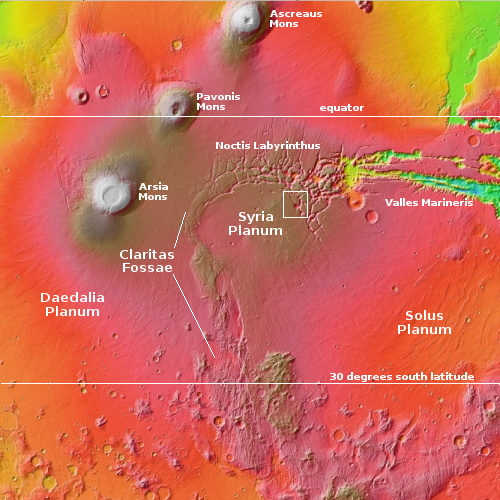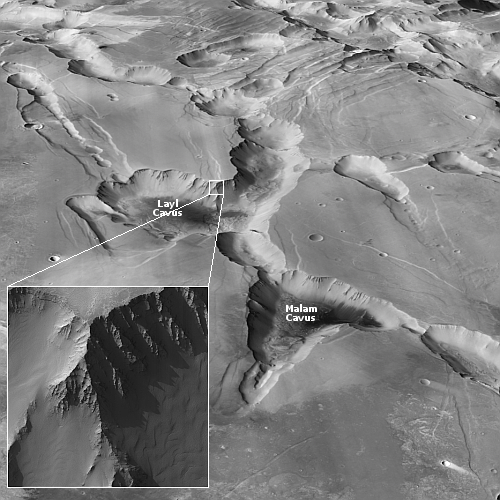The inconceivable scale of Mars’ canyons

Today’s cool image takes us to one of Mars’ biggest canyon systems that while linked to Valles Marineris, the biggest Martian canyon of them all, is considered a separate canyon system because it is made up of a labyrinth of criss-crossing canyons instead of a single major canyon line.
In fact, its name is Noctis Labyrinthus, as shown on the overview map to the right. In many ways its complex pattern is reminiscent of the chaos terrain seen mostly in Mars’ mid-latitudes, but there are major differences. The rectangle marks the area we shall zoom into below to show these differences as well as to feebly illustrate the grand scale of these canyons.
First, the formation of these canyons is closely linked to the volcanic events that formed the three giant volcanoes to the west. They are also strongly linked (in ways not yet fully understood) with the suspected catastrophic floods that drained from Noctis, through Valles Marineris, and out into the northern lowland plains to the east, eons ago when this dry equatorial region could have been wet.
The picture to the right was complied from two different cameras on Mars Rennaissance Orbiter (MRO). The inset comes from a high resolution photo taken on May 15, 2023. The wider view is a mosaic created by the global coverage of MRO’s context camera.
First some numbers. Both Malam Cavus and Layl Cavus are deep, about 12,000 feet, or about two miles. Malam is about 15 by 30 miles across, while Layl is about 22 miles wide. To get a rough idea of the scale, the inset shows only the top half of the descent into the canyon, about 5,000 feet or equivalent to the descent into the Grand Canyon from the South Rim. Yet, this is only halfway down. Moreover, these two giant depressions pale in comparison to Valles Marineris to the east, with a depth of 30,000 feet and an overall width ranging from 40 to 200 miles in places.
Still, the nose of that ridgeline would make a good route for a hiking trail down into Layl Cavus. Imagine the views!
The context camera mosaic reveals some things that are not evident in the high resolution image of that cliff wall. These canyons do not appear to have formed from a flow going through them. Instead, they appear to be gigantic sinkholes, the surface sagging because material underground was being removed, either by sublimation or washed away during those floods.
In fact, the overall geology strongly suggests that some underground material drained down from the volcanoes, flowing underground along faults under Noctis Labyrinthus, and then emerged on the surface at Valles Marineris to carve its way east until it exited into the northern lowland plains.
What was that material? Scientists for decades have reasonably assumed it was liquid water, since these features so closely resemble similar water-carved features on Earth. The problem has always been that no scientist has yet come up with a satisfactory model that would allow liquid water to exist on the surface of Mars. The atmosphere is too thin and cold, causing ice to immediately sublimate into gas.
Could that underground flow have been ice, or a combination of ice and a very temporary melting producing liquid water for short periods of time and thus some lubrication to enhance flow? I am guessing, but I suspect, based on everything I have read about Mars’ research in the past decade, the planetary science community is beginning to lean in this vague direction.
Nothing however can be confirmed until we have actual data from the surface, something that will take decades, possibly centuries, to obtain.
On Christmas Eve 1968 three Americans became the first humans to visit another world. What they did to celebrate was unexpected and profound, and will be remembered throughout all human history. Genesis: the Story of Apollo 8, Robert Zimmerman's classic history of humanity's first journey to another world, tells that story, and it is now available as both an ebook and an audiobook, both with a foreword by Valerie Anders and a new introduction by Robert Zimmerman.
The print edition can be purchased at Amazon or from any other book seller. If you want an autographed copy the price is $60 for the hardback and $45 for the paperback, plus $8 shipping for each. Go here for purchasing details. The ebook is available everywhere for $5.99 (before discount) at amazon, or direct from my ebook publisher, ebookit. If you buy it from ebookit you don't support the big tech companies and the author gets a bigger cut much sooner.
The audiobook is also available at all these vendors, and is also free with a 30-day trial membership to Audible.
"Not simply about one mission, [Genesis] is also the history of America's quest for the moon... Zimmerman has done a masterful job of tying disparate events together into a solid account of one of America's greatest human triumphs."--San Antonio Express-News

Today’s cool image takes us to one of Mars’ biggest canyon systems that while linked to Valles Marineris, the biggest Martian canyon of them all, is considered a separate canyon system because it is made up of a labyrinth of criss-crossing canyons instead of a single major canyon line.
In fact, its name is Noctis Labyrinthus, as shown on the overview map to the right. In many ways its complex pattern is reminiscent of the chaos terrain seen mostly in Mars’ mid-latitudes, but there are major differences. The rectangle marks the area we shall zoom into below to show these differences as well as to feebly illustrate the grand scale of these canyons.
First, the formation of these canyons is closely linked to the volcanic events that formed the three giant volcanoes to the west. They are also strongly linked (in ways not yet fully understood) with the suspected catastrophic floods that drained from Noctis, through Valles Marineris, and out into the northern lowland plains to the east, eons ago when this dry equatorial region could have been wet.
The picture to the right was complied from two different cameras on Mars Rennaissance Orbiter (MRO). The inset comes from a high resolution photo taken on May 15, 2023. The wider view is a mosaic created by the global coverage of MRO’s context camera.
First some numbers. Both Malam Cavus and Layl Cavus are deep, about 12,000 feet, or about two miles. Malam is about 15 by 30 miles across, while Layl is about 22 miles wide. To get a rough idea of the scale, the inset shows only the top half of the descent into the canyon, about 5,000 feet or equivalent to the descent into the Grand Canyon from the South Rim. Yet, this is only halfway down. Moreover, these two giant depressions pale in comparison to Valles Marineris to the east, with a depth of 30,000 feet and an overall width ranging from 40 to 200 miles in places.
Still, the nose of that ridgeline would make a good route for a hiking trail down into Layl Cavus. Imagine the views!
The context camera mosaic reveals some things that are not evident in the high resolution image of that cliff wall. These canyons do not appear to have formed from a flow going through them. Instead, they appear to be gigantic sinkholes, the surface sagging because material underground was being removed, either by sublimation or washed away during those floods.
In fact, the overall geology strongly suggests that some underground material drained down from the volcanoes, flowing underground along faults under Noctis Labyrinthus, and then emerged on the surface at Valles Marineris to carve its way east until it exited into the northern lowland plains.
What was that material? Scientists for decades have reasonably assumed it was liquid water, since these features so closely resemble similar water-carved features on Earth. The problem has always been that no scientist has yet come up with a satisfactory model that would allow liquid water to exist on the surface of Mars. The atmosphere is too thin and cold, causing ice to immediately sublimate into gas.
Could that underground flow have been ice, or a combination of ice and a very temporary melting producing liquid water for short periods of time and thus some lubrication to enhance flow? I am guessing, but I suspect, based on everything I have read about Mars’ research in the past decade, the planetary science community is beginning to lean in this vague direction.
Nothing however can be confirmed until we have actual data from the surface, something that will take decades, possibly centuries, to obtain.
On Christmas Eve 1968 three Americans became the first humans to visit another world. What they did to celebrate was unexpected and profound, and will be remembered throughout all human history. Genesis: the Story of Apollo 8, Robert Zimmerman's classic history of humanity's first journey to another world, tells that story, and it is now available as both an ebook and an audiobook, both with a foreword by Valerie Anders and a new introduction by Robert Zimmerman.
The print edition can be purchased at Amazon or from any other book seller. If you want an autographed copy the price is $60 for the hardback and $45 for the paperback, plus $8 shipping for each. Go here for purchasing details. The ebook is available everywhere for $5.99 (before discount) at amazon, or direct from my ebook publisher, ebookit. If you buy it from ebookit you don't support the big tech companies and the author gets a bigger cut much sooner.
The audiobook is also available at all these vendors, and is also free with a 30-day trial membership to Audible.
"Not simply about one mission, [Genesis] is also the history of America's quest for the moon... Zimmerman has done a masterful job of tying disparate events together into a solid account of one of America's greatest human triumphs."--San Antonio Express-News



Firefly, not FireFire.
And Miranda is the planet where Reavers were “created” in “Firefly”.
Sorry, I meant to associate my previous comment with the post about the Miranda engine.
“Miranda”
River Tam ‘Serenity’ 2005 Universal
The prelude to what is arguably a ranking movie fight scene pound-for-pound.
“Start with the part where Jayne gets knocked out by a 90-pound girl ’cause… I don’t think that’s ever getting old.”
Hoban Washburn ‘Serenity’ 2005 Universal
Blair Ivey,
It is two decades later, and is still isn’t old.